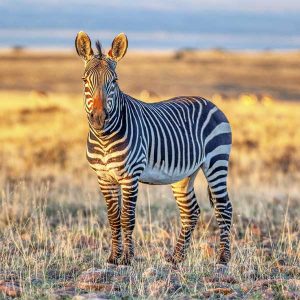Namibia Hunting Safari
Namibia, a country known for its stunning landscapes and abundant wildlife, is a paradise for nature enthusiasts and wildlife photographers. One of the iconic and striking animals that roam its arid plains is the Gemsbok or Gemsbuck. With their distinctive long, straight horns and striking black-and-white markings, these creatures have fascinated visitors and researchers for years. But just how large do these magnificent creatures grow in Namibia? In this article, we will explore the typical size of a Gemsbok in Namibia, shedding light on its physical characteristics and significance in the country’s diverse ecosystem. (Looking for safari tours to Namibia, contact us today! Visit our website for more information)

Physical Characteristics of Gemsbok
Gemsbok, scientifically known as Oryx gazella, are large antelopes native to southern Africa, and they are particularly prevalent in Namibia. These striking animals have several distinct physical features that make them instantly recognizable. To understand their typical size, it’s essential to first delve into these characteristics:
Horns: Gemsbok are renowned for their long, straight, and pointed horns. These remarkable appendages can reach impressive lengths and serve several purposes. The horns are used for self-defense, as well as for digging for water in the arid Namibian desert. In fact, a fully grown Gemsbok’s horns can measure up to 85-100 cm (33-39 inches) in length.
Body: Gemsbok are large and robust animals, with a shoulder height of around 1.2 meters (4 feet) and a body length that can extend up to 1.8 meters (5.9 feet). Males are typically larger than females, but both sexes display impressive size and stature.
Weight: An adult Gemsbok is quite hefty, with males weighing between 200-300 kg (440-660 pounds) and females averaging around 150-250 kg (330-550 pounds). Their sturdy build helps them survive in the harsh, arid landscapes of Namibia.
Coat: The Gemsbok’s coat is a beautiful blend of grayish-tan and white, with striking black facial markings that include bold lines running from their eyes down to their noses. This unique coat helps them to reflect the harsh desert sunlight and regulate their body temperature.
Significance in Namibia’s Ecosystem
Understanding the typical size of Gemsbok in Namibia is not only fascinating from a physical perspective but also because it highlights their ecological importance in the country’s diverse ecosystems. Gemsbok play a vital role in the arid regions of Namibia for several reasons:
Key Prey Species: In Namibia, Gemsbok serve as a crucial prey species for large predators like lions and leopards. Their abundance helps maintain the balance in the predator-prey dynamic, which is essential for the overall health of the ecosystem.
Desert Survivors: Namibia is home to some of the world’s harshest deserts, including the Namib Desert. Gemsbok are well-adapted to these challenging environments, where they can endure extreme temperatures and water scarcity. Their ability to dig for water in dry riverbeds not only sustains them but also creates water sources for other wildlife.
Ecosystem Engineers: Gemsbok are often referred to as “ecosystem engineers” due to their role in shaping the landscape. Their digging and foraging activities have a profound impact on plant communities and soil composition, ultimately influencing the entire ecosystem.
Conservation and Tourism
The Gemsbok’s impressive size and striking appearance have made it a symbol of Namibia’s rich wildlife heritage. Conservation efforts in Namibia are aimed at protecting these magnificent creatures and the entire ecosystem they inhabit. The Burchell Wolff Safaris, for example, is a dedicated organization that offers responsible wildlife viewing opportunities in Namibia.
The Burchell Wolff Safaris, located in Outjo, Namibia, provides visitors with a chance to witness Gemsbok in their natural habitat. With their knowledge and expertise, they contribute to the sustainable development of wildlife tourism, promoting conservation and educating visitors about the importance of preserving these majestic creatures and their environment.
Conclusion:
The typical size of a Gemsbok in Namibia reflects the grandeur and significance of these magnificent creatures. With their impressive body proportions and striking features, Gemsbok is not only a marvel to behold but also plays a vital role in the delicate balance of Namibia’s ecosystems. As they continue to thrive in the arid landscapes of this beautiful country, the conservation efforts by organizations like the Burchell Wolff Safaris ensure that future generations will have the privilege of witnessing these iconic animals in their natural habitat. Namibia’s Gemsbok is a true testament to the resilience and beauty of wildlife in the face of adversity.
